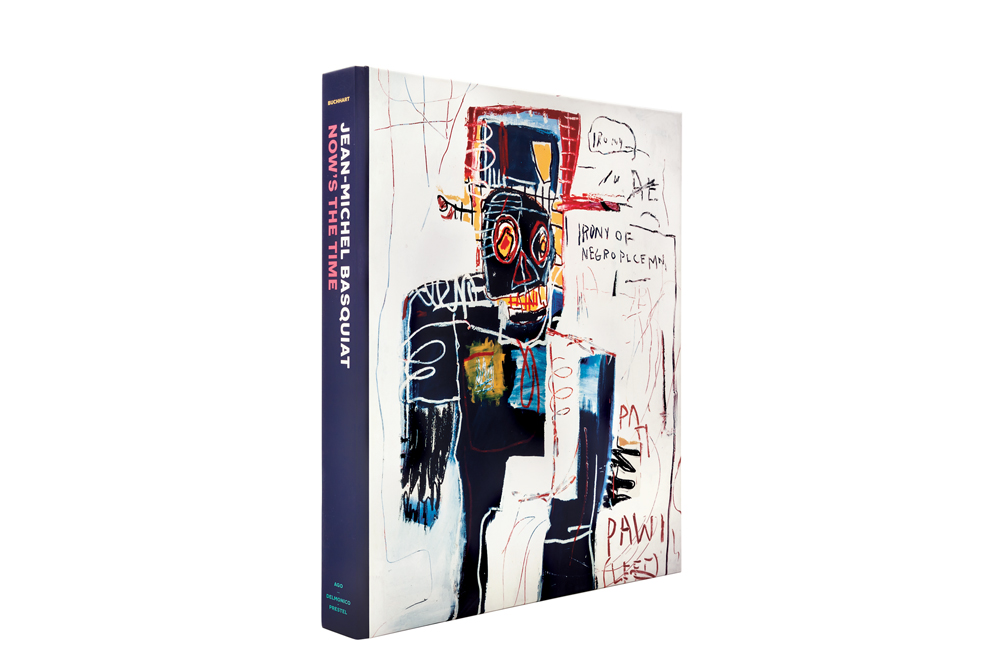This article is based on the Readings section of the Summer 2015 issue of Canadian Art.
Reading is a summer requirement. These might not be your typical beach reads, but you’ll be amply rewarded for carting them to your lounger (or onto your patio, or hammock).
Jean-Michel Basquiat: Now’s the Time
Dieter Buchhart, Art Gallery of Ontario/Prestel, 228 pp, $54.95.
Jean-Michel Basquiat confronted issues of racism, class struggle and social hypocrisy very specific to New York in the 1980s, a scene that exists now only in the memories of a few, but his work still resonates in crystal-clear tones. The essayists in this AGO catalogue attempt to explain why. In his glib crowning of Basquiat as a “punk sage” and “Tesla coil with dreadlocks,” Glenn O’Brien blunders a chance to portray his friend as anything other than the mythological figure built up by the indefatigable cult of his celebrity. Thankfully, curator Dieter Buchhart and University of Toronto professor Christian Campbell probe deeper. Buchhart acknowledges the artist’s prescient anticipation of the copy-paste sampling style of the Internet generation, revealing why his approach still feels so inspiring and aesthetically contemporary, and Campbell explores what Basquiat’s work could mean to multicultural Canadians today, asking, “What is the relationship between Irony of a Negro Policeman and the overpolicing of black people in Toronto?” Will this exhibition aid in ending Canada’s polite silence on race, or, “Will it just stay the SAMO SAMO?”
Painting Beyond Pollock
Morgan Falconer, Phaidon, 384 pp, $79.95.
Critic, art historian and faculty member of Sotheby’s Institute of Art Morgan Falconer has produced a useful book tracking painting since the end of the Second World War. He makes an argument for understanding painting through its history and does a thorough job of capturing the theoretical twists and turns that shaped painting after Pollock. However, you have to reach page 272 to read about painting of the last three decades. This mis-weighting lends an academic air to the proceedings. It makes a reader yearn for a book devoted to the truly recent history of painting.
Kelly Mark: Everything is Interesting
Jonathan Watkins, Christina Ritchie and Dan Adler, Justina M. Barnicke Gallery, 250 pp, $30.00.
It seems that lately, in Canada at least, Douglas Coupland is seen as the chief proprietor of pithy truisms, so this catalogue is a great reminder that Kelly Mark has been totally killing it in the field of vaguely existential witticisms since the 1990s. Images of works like Nothing is so important that it needs to be made in six foot neon (2009) (a six-foot neon text piece) testify to her mastery. Documentation of Mark’s multidisciplinary practice makes up the bulk of the tome, interspersed with excerpted takes on her practice from fellow artists, curators and even novelist Jonathan Safran Foer.
Turning Inward
Edited by Lou Cantor and Clemens Jahn, Sternberg Press, 236 pp, $21.00.
This volume gathers 15 art critics, curators and artists in an open-ended epistemic investigation into how art functions within today’s networked societies. Dieter Roelstrate claims that truly contemporary art emerges from society’s peripheries, which are not easily defined in a polycentric world, and David Joselit takes on Walter Benjamin’s “Kunstwerk,” arguing that the cultural value of art today is in its pervasive ubiquity, not its unique “aura.” A special focus on Berlin examines concepts of being “central” and “peripheral” as strategic modes of artistic production.
Artist Novels
Edited by David Maroto and Joanna Zielinska, Sternberg Press, 200 pp, $35.00.
Literature seems subservient to visual art throughout this pedantic anthology, from Kenneth Goldsmith’s dependable dismissal of storytelling to Joanna Zielińska’s pat, risible assertion that “traditional narrative forms were finally exhausted in the 1990s.” The latter half excerpts vaguely interesting novels from Yayoi Kusama, Matthew Brannon and others. One imagines a much richer volume that explores the conceptual-art context of, say, Kathy Acker, Chris Kraus or William S. Burroughs, or the novelistic outlooks of Kara Walker, Nathalie Djurberg and others.
Sculpture in the Age of Donatello
Edited by Timothy Verdon and Daniel M. Zolli, D Giles Limited, 200 pp, $49.95.
Renovations to the Museo dell’Opera del Duomo in Florence have brought about a remarkable touring exhibition that reached North American audiences this year at the Museum of Biblical Art in New York. For those who didn’t see the exhibition of early Renaissance masterworks by Donatello, Luca della Robbia and Ghiberti, they have recourse to this finely produced catalogue that, thanks to art photographer Antonio Quattrone, delivers impressively sensitive images that capture the subtle textures and gestures of the sculptures.
Surround Audience: New Museum Triennial 2015
Lauren Cornell and Ryan Trecartin, Skira Rizzoli, 304 pp, $60.00.
Exhibitions about the contemporary moment and its possible “futures” can seem strained and ultimately narcissistic. “Surround Audience,” the New Museum’s Triennial of emerging artists, was guilty of some of this, but, in the hands of curators Ryan Trecartin and Lauren Cornell, was largely pensive, rich and self-doubting. Its catalogue contains a wealth of reading material, including essays by Sara O’Keefe, Hito Steyerl and more.









